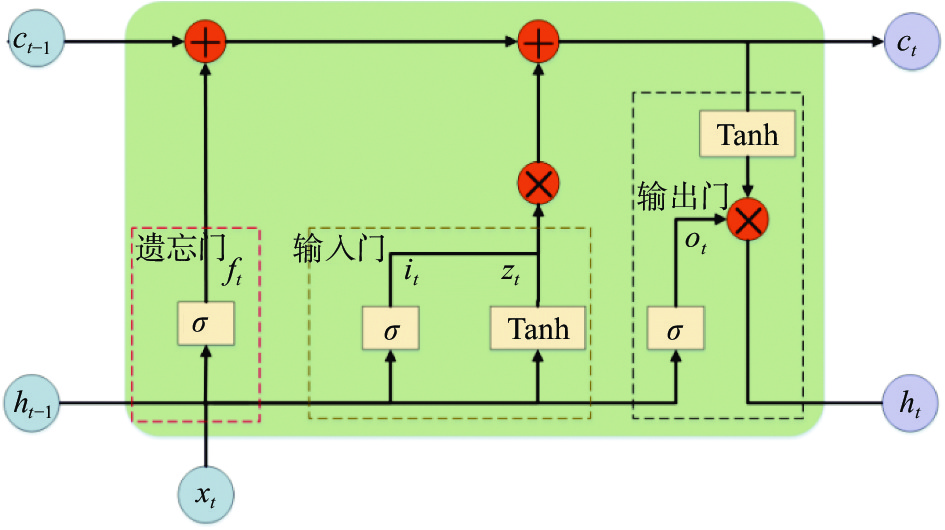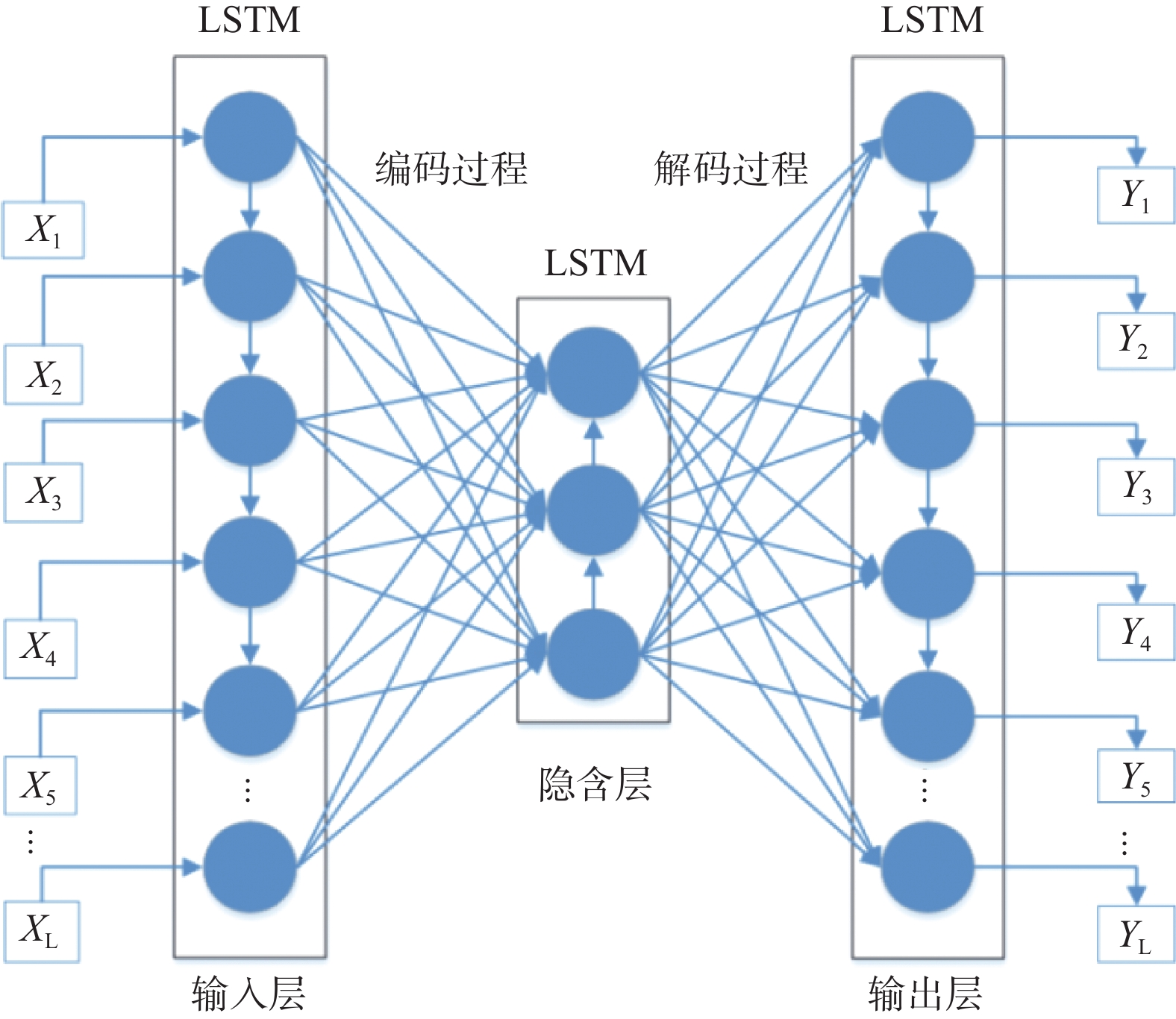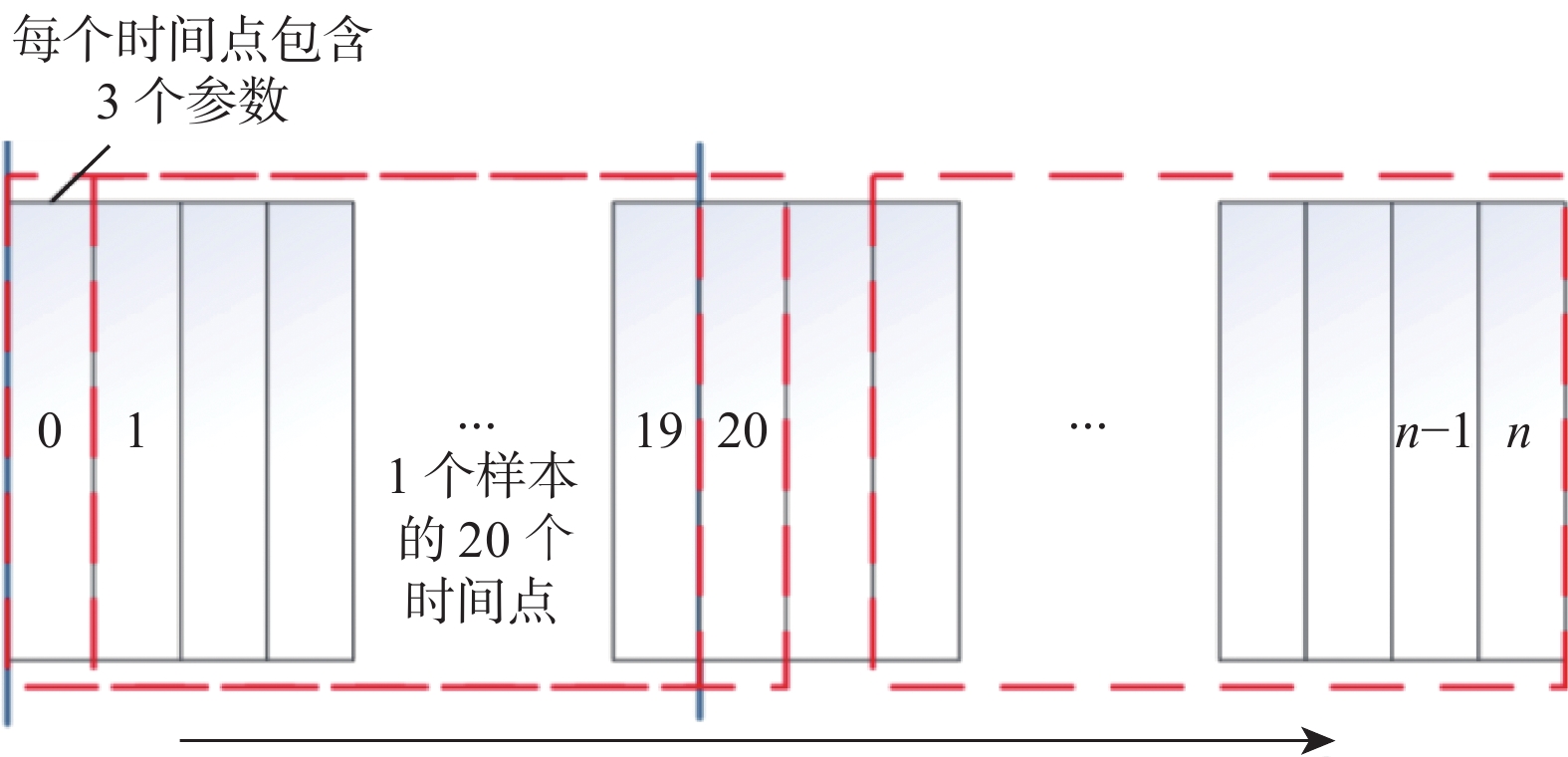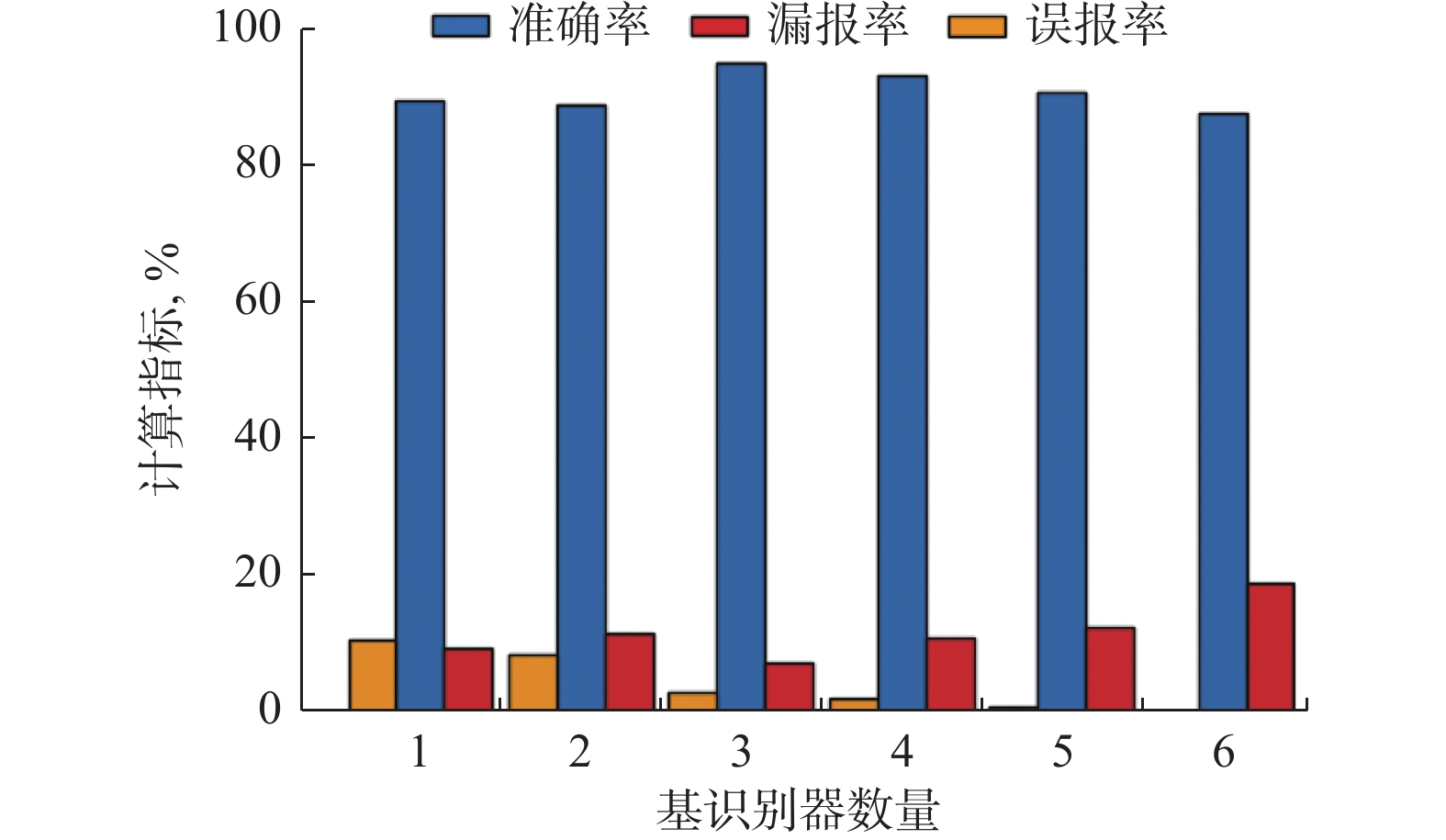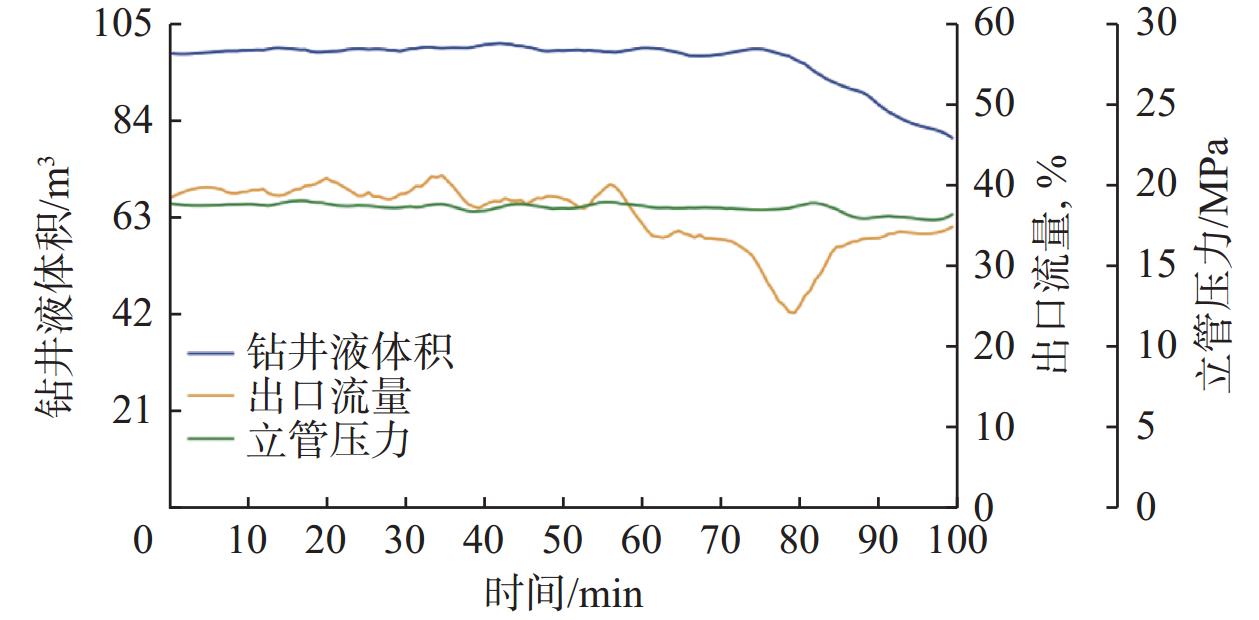An Intelligent Lost Circulation Recognition Method Using LSTM-Autoencoder and Ensemble Learning
-
摘要:
为了解决传统的井漏智能识别模型因井漏样本数量受限导致其识别准确率低的问题,提出了一种长短期记忆(long short-term memory,LSTM)网络与自编码器(auto-encoder,AE)相结合、集成LSTM-AE的井漏智能识别方法。首先,采用正常样本训练多个包含不同隐藏层神经元数目的LSTM-AE模型,利用重构得分筛选出识别效果较好的几个模型作为基识别器;然后,采用集成学习对多个基识别器的识别结果进行加权融合,解决单一模型因对样本局部特征过度学习导致的误报与漏报问题,提高模型的识别准确率。从某油田18口井的钻井数据中选取了6 000组正常钻进状态下的立压、出口流量、池体积数据,对集成LSTM-AE模型进行训练和测试,结果表明,提出方法的识别准确率达到了94.7%,优于其他常用的智能模型的识别结果,为井漏识别提供了一种新的技术途径。
Abstract:To enhance the low recognition accuracy of traditional intelligent lost circulation models, which suffer from limited samples, this study combined the long short-term memory (LSTM) network and auto-encoder (AE) to create an integrated LSTM-AE-based intelligent lost circulation recognition model. Initially, multiple LSTM-AE models with varying numbers of hidden neurons were trained using normal samples. Several models with better recognition performance were selected as base recognizers based on their reconstruction scores. Subsequently, the recognition results from these base recognizers were fused using ensemble learning. This approach addresses the tendency of a single model to produce false alarms and missed alarms due to overlearning of local sample characteristics, thereby improving the recognition accuracy of the model. The integrated LSTM-AE model was trained and tested using 6000 sets of stand pipe pressure, outlet flow, and mud pit volume data from 18 wells under normal drilling conditions in an oilfield. The results show that the proposed method achieves a recognition accuracy of 94.7%, surpassing the recognition results of other commonly used intelligent models. This approach offers a novel method for lost circulation recognition.
-
深层、超深层油气和非常规油气资源的开发,面临高风险、高成本和低效率等挑战。智能决策与主动控制技术是解决上述问题的重要手段,但由于受到钻具组合力学特性的影响,安装在螺杆上游的测量装置难以获得钻头位置处的真实数据,造成智能模型的训练样本存在严重的数据偏见导致,智能钻井在决策控制层面存在不可预测的实施风险。对此,国际石油公司研发了BlackBox™、MultiSense™、Cerebro™等一系列钻头内参数测量装置[1–3],可以安装于钻头内部,在不改变现有钻具组合和施工工艺的前提下直接采集钻头位置处的真实数据,探究钻探功能障碍、预估钻具风险、优化钻具组合与钻井参数。目前,国际石油公司已经实现智能钻头完整数据的采集、分析、优化服务[4–11],并在全球应用130余井次,综合提速最高可达200%。国内中国石化、中国石油等单位的少数科研机构研制了类似样机,但未配套进行数据挖掘与理论研究,因此,暂未实现商业化应用。
针对上述现状,笔者基于微机电传感器,研制开发了一种探管式智能钻头参数测量装置,在不改变现有钻具组合和定向施工工艺的前提下直接安装在钻头内部,获得钻头位置处的真实数据。该装置已在现场试验9井次,验证了其可靠性。同时,基于实测数据,对智能钻头数据分析与应用技术进行了探索。
1. 探管式智能钻头参数测量装置研制
1.1 测量装置的设计与优化
根据刚体运动理论,刚体上任意位置质点的运动参数可由刚体运动方程反推得出。因此,设计常规井下测量工具时,通常可选用钻具外壁开槽偏置式安装或内部悬挂探管中心式安装2种方案。为尽量避免改变钻头本体结构与力学强度,采用了中心安装探管的设计思路。
探管式智能钻头参数测量装置的外形为锥形,总长170 mm,直径25~30 mm。该装置由外筒、端盖、套筒、测量模块和电池模块构成,如图1所示。电池模块外径16 mm,内含耐温150 ℃的AA规格电池,通过螺纹与测量模块连接。测量模块由三轴加速度传感器、陀螺仪、存储芯片与控制芯片构成,通过USB Type-C实现与上位机的数据通讯,板载尺寸25 mm×10 mm;模块嵌入铝合金骨架内部并双层灌注有机硅与环氧树脂胶,以进行绝缘密封,并避免装置结构弹性变形可能引起的模块损坏;测量模块骨架整体呈圆柱状,中部为六方结构,起限位作用。端盖与外筒采用梯形螺纹配合O形密封结构进行连接与密封。外筒由2个支架底座固定于钻头上部公扣中轴线位置处,支架基于翼板形成“品”字形流体通道。
根据流体力学原理,安装于中心探管式装置的压耗主要由上下游端部形态与环空间隙决定,冲蚀程度由上游端部形态决定。因此,初选凸圆结构建立循环压耗与固相冲蚀模型,进一步进行参数优化。以ϕ215.9 mm PDC钻头适配的4½" REG螺纹为例,在30 L/s流量下,模拟外径24~30 mm探管式装置的循环压耗和流场,结果如表1和图2所示。
表 1 不同端部结构探管式装置的循环压耗Table 1. Circulating pressure loss of probe tube devices with different end structures端部结构尺寸 循环压耗/ MPa 外形 外径/ mm 两端结构优化后 上游结构优化后 半球形 D1= D2=24 0.0410 0.1020 半球形 D1= D2=26 0.0540 0.1270 半球形 D1= D2=28 0.0740 0.1560 半球形 D1= D2=30 0.0970 0.1910 椭球形 D1=24,D2=36 0.0350 0.0901 椭球形 D1=24,D2=48 0.0310 0.0904 注:D1为椭球小径或半球直径(与探管直径相等),mm;D2为椭球大径或半球直径,mm。 从表1和图2可以看出,受2种结构导流效果影响,上下游均选用球形结构,有利于避免在下游产生涡流。同参数条件下,椭球结构的循环压耗最低,半球结构的循环压耗最高;循环压耗随 D2增大而降低,随D1增大急剧升高。
在入口处按时间均匀释放密度2 200 kg/m3、直径70 μm的固相颗粒,冲蚀时间10 ms,绘制半球与椭球结构的累计冲蚀量曲线,如图3所示。
从图3可以看出:上下游均为球形结构时,有利于减少冲蚀,且各位置处最大累计蚀程量与管径成反比;相对而言,椭球结构最大累计冲蚀量发生于顶部尖端位置,但整体上维持在较低的冲蚀水平;对于半球结构,虽然尖端位置最大冲蚀量较小,但随着径向距离增大,最大累计冲蚀量逐渐增大。上下游圆顶(D1= D2=24 mm)结构的平均最大累计冲蚀量为2.06×10−16 kg/m2,相对于椭球结构的2.99×10−16 kg/m2下降了31.1%。
因此,综合考虑椭球和半球结构的冲蚀与循环压耗情况,采用半球+椭球复合的纺锤形结构,以获得更好的水力性能与抗冲蚀性能。对新结构进行模拟计算,可绘制探管式装置循环压耗图版(见图4,图中的Φ为钻头接箍内径,mm;Δp为对应尺寸下的循环压耗,MPa;Q为排量,L/s)和对照表(见表2)。
表 2 探管式智能钻头参数测量装置循环压耗对照(30 L/s)Table 2. Circulating pressure loss of probe-type intelligent bit parameter measurement device (30 L/s)钻头直径/mm 连接螺纹 内径/mm 循环压耗/MPa 142.9~171.5 3½" REG 38 0.635 550 190.5~212.7 4½" REG 58 0.019 350 241.3~342.9 6⅝" REG 89 0.007 848 需要注意的是,探管式智能钻头参数测量装置由支撑臂固定于底座上,钻头破岩时的轴扭应变被支撑臂吸收(见图5),虽无需考虑探管本体抗压、抗扭性能,但仍应考虑探管受内环空流体挤压作用下的弹性变形破坏测量模块电路板的风险。取环空压力80 MPa、探管材质为铍铜,进行数值模拟(见图6),结果表明,探管在内部界面转折、骨架安装排气孔处发生应力集中,最小安全系数3.06,满足强度要求;测量模块的最大位移27.5 μm,可以被测量模块的铝合金骨架完全吸收,满足集成电路保护要求。
此外,油气钻井持续时间较长,考虑起下钻时间与经济成本,通常要求井下测量装置具有100 h以上的工作能力。但是,由于受到存储芯片与电池容量的限制,小型化的钻头内参数采集装置不具备长时间、高频率连续工作的能力。因此,为减少电量消耗和延长存储续航时间,将装置配置为变频工作与待机休眠2种模式,可以通过上位机与嵌入式系统的配合,对工作区间、采样频率进行针对性的分组配置,避免装置在起下钻、静置循环、低速钻进阶段额外消耗电量,从而实现探管式智能钻头参数测量装置长时间续航工作。
1.2 误差分析与标定降噪
对于微机电传感器,测量误差主要由确定性误差和随机误差2部分构成。其中,确定性误差主要来源于传感器坐标轴不垂直产生的正交误差、传感器坐标轴与装置坐标轴不一致所产生的对齐误差、受环境影响传感器输出值的敏感性误差与零点漂移误差等4项。
一般而言,传感器芯片出厂时已近似正交状态,其偏差角度极小,可以忽略。根据线性代数原理,线性空间内任意矢量可以用线性无关的基表示,通过基底变换,矢量可用空间内任意笛卡尔坐标系表示。因此,总是存在欧拉角ψ,θ和γ,使测量装置坐标系可以通过依次绕z轴旋转角度ψ、绕x轴旋转角度θ、绕y轴旋转角度γ与传感器坐标系对齐。其表达式为:
\begin{gathered} {\boldsymbol{R}^{{\text{Sensor}}}} = \left[ {\begin{array}{*{20}{c}} {\cos \gamma \cos \psi + \sin \gamma \sin \psi \sin \theta }&{\sin \psi \cos \theta }&{\sin \gamma \cos \psi - \cos \gamma \sin \psi \sin \theta } \\ { - \cos \gamma \sin \psi + \sin \gamma \cos \psi \sin \theta }&{\cos \psi \cos \theta }&{ - \sin \gamma \sin \psi - \cos \gamma \cos \psi \sin \theta } \\ { - \sin \gamma \cos \theta }&{\sin \theta }&{\cos \gamma \cos \theta } \end{array}} \right]{\boldsymbol{R}^{{\text{System}}}} \\ \quad\quad\quad= {{C}_{i,j}}{\boldsymbol{R}^{{\text{System}}}} \\ \end{gathered} (1) 式中:
{\boldsymbol{R}^{{\text{Sensor}}}} 和{\boldsymbol{R}^{{\text{System}}}} 分别为传感器坐标系与测量装置坐标系的基向量。同时,考虑传感器各轴敏感性误差系数与零点漂移,传感器的确定性误差公式可表示为:
\begin{split} {\boldsymbol{R}^{{\text{Sensor}}}} =& \left[ {\begin{array}{*{20}{c}} {{s_{xx}}}&{}&{} \\ {}&{{s_{yy}}}&{} \\ {}&{}&{{s_{zz}}} \end{array}} \right]\left[ {\begin{array}{*{20}{c}} {{C_{xx}}}&{{C_{xy}}}&{{C_{xz}}} \\ {{C_{yx}}}&{{C_{yy}}}&{{C_{yz}}} \\ {{C_{zx}}}&{{C_{zy}}}&{{C_{zz}}} \end{array}} \right]{\boldsymbol{R}^{{\text{Real}}}} + \\& \left[ {\begin{array}{*{20}{c}} {{\delta _{xx}}} \\ {{\delta _{yy}}} \\ {{\delta _{zz}}} \end{array}} \right] = \boldsymbol{A} \cdot {\boldsymbol{R}^{{\text{Real}}}} + \boldsymbol{\delta } \end{split} (2) 式中:
{S_{ij}} ,{C_{ij}} 和{\delta _{ij}} 分别为测量装置的敏感性系数、安装误差系数、零点漂移系数;{\boldsymbol{A}} 为标定矩阵;{\boldsymbol \delta } 为零点漂移矩阵;{\boldsymbol{R}^{{\text{Real}}}} 为不含误差的真实数据。以加速度传感器为例,采用6面静置测量法,依次以测量装置x,y和z轴正负两向竖直向上获得6组测量数据M。联立求解,得到确定性误差系数的表达式为(陀螺仪标定与之类似,采用6轴恒转速法标定):
\left\{ {\begin{array}{*{20}{l}} {{A_{i,j}} = \left( {M_i^{j \to + {{90}^ \circ }} - M_i^{j \to - {{90}^ \circ }}} \right)/2} \\ {{\delta _{ii}} = \sum {M/6} } \end{array}} \right. (3) 采用Allen法对测量装置进行随机误差分析,结果如图7所示。测量工具传感器的误差主要源于随机游走及零偏不稳定性。
计算样本数据的自相关系数与偏自相关系数发现样本数据高阶拖尾,则测量装置随机误差可采用ARMA模型表征(见图8)。构建Kalman移动滤波器进行随机噪声降噪(见图9)。对比图8、图9可以发现:低阶ARMA模型对原始数据的拟合效果相对较好;随着ARMA模型阶数增加,滤波降噪效果虽然增强,但效果有限。因此,在不追求较高精度的前提下,可采用低阶模型建立随机噪声模型降噪。
2. 现场试验与案例分析
2.1 现场试验情况
基于前文内容与笔者前期研究基础[12],加工了探管式智能钻头样机3台,在胜利油田牛页、义页、渤深等区块进行了9井次探管式智能钻头参数测量装置试验。配套井下工程参数测量短节开展了装置功能验证与井下数据对比,融合综合录井数据开展了试验井提速分析与参数优化。结果表明,探管式智能钻头参数测量装置能够获取钻头位置处的真实运动参数,能够为制定针对性提速提效技术措施与钻井参数优化提供可靠依据。
2.2 试验案例分析
2.2.1 智能钻头与井下工程参数测量短节数据对比
以胜利油田渤海某井为例,使用ϕ215.9 mm探管式智能钻头配套ϕ172.0 mm动力钻具+回压阀/稳定器+ϕ172.0 mm工程参数测量短节下部钻具组合,进行测量数据对比,结果如图10所示。
从图10可以看出,除采样频率差异外,钻头位置处运动参数与螺杆上游数据在幅值和曲线形态上存在明显差异,验证了研制智能钻头参数测量装置的必要性。
2.2.2 长筒取心实测数据分析与优化探索
以胜利油田义页某井为例,智能钻头采用整趟钻低频采样、关键层位高频加密采样的策略,通过后期时间对齐与综合录井/井下工程参数短节数据融合,数据细节更为丰富、可读性更强(见图11)。该试验中,下钻16 h后在取心钻进井段开始测量采集数据,7 h后割心起钻、测量完毕,17 h后工具出井,1~200 Hz自定义跳频连续采集47 h,数据完整,特征清晰。
对取心钻进测量数据进行时序分析,结果如图12所示。整体而言,受重力加速度影响,钻头轴向加速度为1g±(0~2)g,轴向振动整体处于低水平状态、小部分时段内达到中等水平,无需进行参数控制;侧向振动等级则随取心的进行表现出明显的差异,部分时段达到了严重状态,需要进行控制;部分时段内筒平均转速趋近于0,造成SSI畸高异常,故采用常规扭转振动评价标准,整体转速变化量为±(0~40) r/min,属于低水平状态。需要注意的是,由于取心工具与工艺的特殊性,测量模块安装于取心筒内筒,不随钻具旋转,理论转速为0。但实际应用过程中,在钻压作用下取心筒内、外筒势必发生弯曲与接触,导致内筒在摩擦力作用下被外筒带动旋转,内筒在一定程度上反映外筒的粘滑;随着岩心入筒长度增加,内筒惯性与相对刚性增强,摩擦力无法继续保持内外筒同步旋转,此时内外筒仅有粘滑趋势一致,但强度存在差异。因此,常规扭转评价标准仅能作为初步参考。同时,由于内筒平均转速趋近于0,SSI计算值畸高,亦不便于作为此次测量评价标准。但是,除转速变化的直观表现外,扭转、粘滑同样会造成切向加速度的改变。因此,此次测量中粘滑情况在一定程度上可用侧向振动情况体现。
对取心段加速度数据进行频谱与时频分析,结果如图13所示。
从图13可以看出:轴向振动主频特征极为明显,频谱和时频分别为4和10 Hz;侧向振动由于引发因素过多,在频谱和时频图中的特征不明显。
分别对测量段中低、高、严重3个等级的侧向振动信号进行频谱分析,结果如图14所示。
从图14可以看出,高和严重等级侧向振动主要由低频信号表征,低和中等级振动主要由高频信号表征。
对侧向振动进行模态分解,取心段数据可以分解为12阶,前10阶如图15所示。
从图15可以看出,信号主频在各频段均有分布,但主要集中于160,40,20,8,1~2和<0.5 Hz等特征点附近,分属扭转共振(160 Hz)、涡动(8~40 Hz)、粘滑(0~2 Hz)。结合相对功率谱密度对比结果,认为在该井取心段,中低等级侧向振动主要由扭转共振与涡动引发,严重等级的侧向振动主要由低频粘滑引发。
分析振动与钻井参数的相对关系,结果见图12和表3。取心作业刚开始时,由于取心筒内岩心长度不足(0~5 m),其自重与相对刚性较弱,底部钻具在60~70 kN钻压下表现为加速度±0.7g(低)的轴向跳动与加速度0~9g(严重)的侧向振动。取心1~2 h时,筒内岩心长度6.0~10.0 m,钻压稳定于55~60 kN,底部钻具轴向振动加速度±1.5g(中),侧向振动加速度0~4.5g(高)。取心2~3 h时,筒内岩心长度10.0~13.0 m,钻压下调至40~45 kN,轴向振动加速度±1.2 g(中)、侧向振动加速度0~4.0g(高)。取心3~4 h,筒内岩心长度13.0~13.7 m时,钻压稳定于55 kN,轴向振动加速度±0.9g(低),侧向振动加速度0~9g(严重);筒内岩心长度13.7~14.3 m时,钻压升至85 kN,但取心钻速并未明显改变,短起下钻一次。取心5~6 h,筒内岩心长度14.3~15.3 m时,钻压从35 kN上调至95 kN,轴向振动加速度基本稳定于±0.7g(低),侧向振动加速度逐步增至0~8.5g(低→严重);筒内岩心长度15.3~16.0 m时,钻压稳定于85~95 kN,轴向振动加速度稳定于±0.6g,侧向振动加速度降至0~7g(严重)。由此可知,底部钻具在整体上服从轴向振动与钻压负相关、侧向振动与钻压正相关的影响规律。同时,随着取心筒内岩心长度增长,取心筒自重与刚度相对增强,相同钻压作用下,其轴向振动相对减弱、侧向振动相对增强。因此,建议通过优化钻头齿与刀翼结构的形式提高取心钻头的进攻性与抗回旋性,并采用低钻压、高转速的钻进参数进行取心作业。同时,随着取心长度增长,可在不影响钻速的前提下适当降低钻压,以降低振动等级与钻具磨损速度、提高钻进效率与取心率(避免筒内岩心在涡动、侧向撞击影响下发生断裂与破碎)。对于胜利油田这口义页某井,建议钻压为50~60 kN。
表 3 取心钻进段振动特征与作业参数的关系Table 3. Relationship between vibration characteristics of core drilling section and operation parameters岩心长度/m 钻压/kN 轴向振动加速度/g 侧向振动加速度/g 0~6.0 60~70 0.7 (低) 9.0 (严重) 6.0~10.0 55~60 1.2 (中) 4.5 (高) 10.0~13.0 40~45 1.2 (中) 5.0 (高) 13.0~13.7 55 0.9 (低) 9.0 (严重) 14.3~15.3 35~95 0.7(低) 8.5(严重) 15.3~16.0 85~95 0.6 (低) 7.0 (严重) 2.2.3 钻井参数优化
前述分析方法是通过定性诊断钻头工况为钻井参数优化提供依据,本质上仅是对已有实钻参数进行对比分析,在有限范围内选择相对优秀的钻井参数,无法保证其参数在全域范围内最优。因此,前期研究中统筹考虑钻速、比能、振动、单位进尺成本等关键参数的让步竞争关系,提出了钻井参数的多目标优化方法 [13–15]。仍以胜利油田义页某井为例,采用实测数据作为训练样本建立神经网络模型,获得目标井深关键钻井参数预测云图(见图16),锁定参数优化控制边界;基于粒子群算法与多目标博弈模型,获得目标井深钻井参数优化云图(见图17)。由此可知,预计钻压为62 kN时,可以实现经济、风险、效率的统一,钻压为50~60 kN时,相对经济成本较高,但整体风险更低,优化结果与前述分析结果基本一致。
需要注意的是,长筒取心钻进与常规PDC钻头钻进不同,内筒仅在摩擦力带动下随外筒旋转,悬挂于内筒探管式装置所测的转速数据存在缺陷;且现场未进行转速试验,训练缺乏高转速、高钻压条件下的实测数据。因此,对于此次多目标优化,训练样本存在一定的缺陷,仅用作智能钻参决策方法的验证测试,其钻压优化结果相对可靠,但转速优化结果仅作定性参考,不可定量使用。
3. 结 论
1)研制了一种探管式智能钻头参数测量装置,可以在不改变现有钻具组合和施工工艺的前提下直接安装在钻头内部,具备测量钻头位置处振动、转速、井温、井斜角等4个参数的能力。基于数值模拟开展了装置硬件结构优化,30 L/s排量与80 MPa环空压力条件下,理论水力压耗小于0.1 MPa,安全系数可达3.06。
2)通过上位机与嵌入式系统的配合,实现了测量装置变频工作与待机休眠模式的切换,通过对工作区间、采样频率进行针对性分组配置,可以避免装置在起下钻、静置循环、低速钻进阶段额外消耗电量,实现了装置的长时间续航工作;基于六面法、Allen方差分析、ARMA建模、移动Kalman滤波,实现了装置的误差标定与建模降噪。
3)探管式智能钻头参数测量装置进行了9井次现场试验。配套对比工程参数短节测量数据,证实了钻头内测量数据与螺杆上游测量数据的差异性,验证了研制智能钻头参数测量装置的必要性;融合胜利油田义页某井实测数据,对智能钻头数据特征和工况进行了分析,基于振动烈度和作业参数的量化分级与趋势对比,明确了钻压50~60 kN的经验化建议;建立了关键参数预测与钻井参数多目标博弈模型,最优钻压62 kN,与经验分析结果一致。
-
表 1 不同神经元数量LSTM-AE模型重构结果的对比
Table 1 Comparison of reconstruction performance of LSTM-AE with different numbers of neurons
序号 LSTM层神经元数 误差阈值 重构得分 1 12 0.019 3.95 2 11 0.045 3.05 3 4 0.060 2.74 4 3 0.071 2.57 5 6 0.074 2.51 6 15 0.076 2.49 表 2 不同模型井漏识别结果的对比
Table 2 Comparison of lost circulation recognition results of different models
方法 误报率,% 查全率,% 查准率,% 准确率,% 集成LSTM-AE 2.6 97.1 92.3 94.7 LSTM 3.9 95.8 90.3 93.4 SVM 1.0 98.7 79.0 89.0 随机森林 1.4 98.8 85.1 92.0 决策树 7.8 91.0 82.6 87.4 -
[1] 陈钢花,何宇龙,邱正松,等. 钻井过程中井漏特征精细识别方法研究与应用[J]. 石油钻探技术,2024,52(1):26–31. CHEN Ganghua, HE Yulong, QIU Zhengsong, et al. Research and application for the fine identification method of lost circulation characteristics during drilling[J]. Petroleum Drilling Techniques, 2024, 52(1): 26–31.
[2] 李中. 中国海油油气井工程数字化和智能化新进展与展望[J]. 石油钻探技术,2022,50(2):1–8. LI Zhong. Progress and prospects of digitization and intelligentization of CNOOC’s oil and gas well engineering[J]. Petroleum Drilling Techniques, 2022, 50(2): 1–8.
[3] 徐哲,李建,王兵,等. 基于贝叶斯网络的钻井井漏问题研究[J]. 石油天然气学报,2013,35(12):125–129. XU Zhe, LI Jian, WANG Bing, et al. Research on well leakage in drilling based on Bayesian network[J]. Journal of Oil and Gas Technology, 2013, 35(12): 125–129.
[4] 刘彪,李窚晓,李双贵,等. 基于支持向量回归的井漏预测[J]. 钻采工艺,2019,42(6):17–20. doi: 10.3969/J.ISSN.1006-768X.2019.06.05 LIU Biao, LI Chengxiao, LI Shuanggui, et al. Lost circulation prediction based on support vector regression[J]. Drilling & Production Technology, 2019, 42(6): 17–20. doi: 10.3969/J.ISSN.1006-768X.2019.06.05
[5] 史肖燕,周英操,赵莉萍,等. 基于随机森林的溢漏实时判断方法研究[J]. 钻采工艺,2020,43(1):9–12. SHI Xiaoyan, ZHOU Yingcao, ZHAO Liping, et al. Study on how to determine kicks and losses in real time on basis of random forest method[J]. Drilling & Production Technology, 2020, 43(1): 9–12.
[6] 杨传书,李昌盛,孙旭东,等. 人工智能钻井技术研究方法及其实践[J]. 石油钻探技术,2021,49(5):7–13. YANG Chuanshu, LI Changsheng, SUN Xudong, et al. Research method and practice of artificial intelligence drilling technology[J]. Petroleum Drilling Techniques, 2021, 49(5): 7–13.
[7] 葛亮,滕怡,肖国清,等. 基于井下环空参数的溢流智能预警技术研究[J]. 西南石油大学学报(自然科学版),2023,45(2):126–134. GE Liang, TENG Yi, XIAO Guoqing, et al. Research on overflow intelligent warning technology based on downhole annulus parameters[J]. Journal of Southwest Petroleum University(Science & Technology Edition), 2023, 45(2): 126–134.
[8] 孙伟峰,卜赛赛,张德志,等. 基于DCC-LSTM的钻井液微量漏失智能监测方法[J]. 天然气工业,2023,43(9):141–148. SUN Weifeng, BU Saisai, ZHANG Dezhi, et al. DCC-LSTM based intelligent minor lost circulation monitoring method[J]. Natural Gas Industry, 2023, 43(9): 141–148.
[9] 张矿生,宫臣兴,陆红军,等. 基于集成学习的井漏智能预警模型及智能推理方法[J]. 石油钻采工艺,2023,45(1):47–54. ZHANG Kuangsheng, GONG Chenxing, LU Hongjun, et al. Intelligent early warning model and intelligent reasoning method based on integrated learning for loss circulation[J]. Oil Drilling & Production Technology, 2023, 45(1): 47–54.
[10] 王钰豪,郝家胜,张帆,等. 钻井溢流风险的自适应LSTM预警方法[J]. 控制理论与应用,2022,39(3):441–448. WANG Yuhao, HAO Jiasheng, ZHANG Fan, et al. Adaptive LSTM early warning method for kick detection in drilling[J]. Control Theory & Applications, 2022, 39(3): 441–448.
[11] 谭天一,张辉,马丹妮,等. 考虑数据不平衡影响的钻井复杂智能诊断方法[J]. 石油钻采工艺,2021,43(4):449–454. TAN Tianyi, ZHANG Hui, MA Danni, et al. An intelligent drilling accident diagnosis method considering the influence of data imbalance[J]. Oil Drilling & Production Technology, 2021, 43(4): 449–454.
[12] 杨岳毅,王立德,陈煌,等. 基于变分自编码器的MVB网络异常检测方法[J]. 铁道学报,2022,44(1):71–78. YANG Yueyi, WANG Lide, CHEN Huang, et al. Anomaly detection method for MVB network based on variational autoencoder[J]. Journal of the China Railway Society, 2022, 44(1): 71–78.
[13] 王晓玉,刘桂芳,韩宝坤,等. 堆叠自编码器在样本不充足下的轴承故障诊断方法[J]. 噪声与振动控制,2021,41(2):100–104. WANG Xiaoyu, LIU Guifang, HAN Baokun, et al. Stacked autoencoders for bearing fault diagnosis under the condition of insufficient samples[J]. Noise and Vibration Control, 2021, 41(2): 100–104.
[14] 秦婉亭,老松杨,汤俊,等. 基于变分自编码器的飓风轨迹异常检测方法[J]. 系统仿真学报,2021,33(9):2191–2201. QIN Wanting, LAO Songyang, TANG Jun, et al. Hurricane trajectory outlier detection method based on variational auto-encode[J]. Journal of System Simulation, 2021, 33(9): 2191–2201.
[15] 田晟,宋霖. 基于CNN和Bagging集成的交通标志识别[J]. 广西师范大学学报(自然科学版),2022,40(4):35–46. TIAN Sheng, SONG Lin. Traffic sign recognition based on CNN and Bagging integration[J]. Journal of Guangxi Normal University(Natural Science Edition), 2022, 40(4): 35–46.
[16] 陈江,单桂军,李正明. 基于支持向量机集成学习的网络故障诊断方法[J]. 计算机测量与控制,2014,22(12):3906–3908. CHEN Jiang, SHAN Guijun, LI Zhengming. Network fault diagnosis based on support vector machine ensemble learning[J]. Computer Measurement & Control, 2014, 22(12): 3906–3908.
[17] 徐晓芳,管瑞. 基于神经网络集成学习算法的金融时间序列预测[J]. 计算机系统应用,2022,31(6):29–37. XU Xiaofang, GUAN Rui. Financial time series forecasting based on neural network ensemble learning algorithms[J]. Computer Systems & Applications, 2022, 31(6): 29–37.
[18] YU Yong, SI Xiaosheng, HU Changhua, et al. A review of recurrent neural networks: LSTM cells and network architectures[J]. Neural Computation, 2019, 31(7): 1235–1270. doi: 10.1162/neco_a_01199
[19] 王海彪. 井漏智能识别及处理决策研究[D]. 成都:西南石油大学,2017. WANG Haibiao. Study of intelligent recognition and management decisions of lost circulation[D]. Chengdu: Southwest Petroleum University, 2017.
[20] 蔺研锋,闵超,代博仁,等. 基于动态特征和深度神经网络的钻井漏失事故预测[J]. 西安石油大学学报(自然科学版),2022,37(3):64–69. LIN Yanfeng, MIN Chao, DAI Boren, et al. Prediction of drilling leakage accident based on dynamic features and deep neural network[J]. Journal of Xi’an Shiyou University(Natural Science Edition), 2022, 37(3): 64–69.
[21] 孙伟峰,刘凯,张德志,等. 结合钻井工况与Bi-GRU的溢流与井漏监测方法[J]. 石油钻探技术,2023,51(3):37–44. SUN Weifeng, LIU Kai, ZHANG Dezhi, et al. A kick and lost circulation monitoring method combining Bi-GRU and drilling conditions[J]. Petroleum Drilling Techniques, 2023, 51(3): 37–44.
-
期刊类型引用(3)
1. 丁宇奇,李康健,范清泉,芦烨,吕奇霖,贾威. 开窗侧钻对钻柱螺纹应力与密封性能的影响分析. 石油钻探技术. 2024(04): 75-86 .  本站查看
本站查看
2. 贾朋,房军,吴烁. 被动轮式推进器设计. 中国石油大学学报(自然科学版). 2021(01): 183-192 .  百度学术
百度学术
3. 马卫国,卢雷,王刚,李金洪,梅雪松,杨毅成. 基于AMESim的连续管注入头夹持力动态特性研究. 石油机械. 2018(05): 65-70 .  百度学术
百度学术
其他类型引用(3)




 下载:
下载:



























